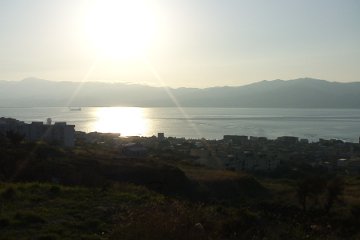Dangerous Straits

| |
| The northern end of the Straits of Messina. We arrived there on one of our tours shortly before sunset. |
The Straits of Messina, which separate Sicily from the toe of Italy, have always been perilous waters. The tide, rushing through the three mile wide gap, causes whirlpools and unpredictable currents that have brought distaster to many a mariner. Even the dauntless Odysseus claims to have lost three men to the monsters Scylla and Charybdis, now widely recognised as natural features — whirlpools and hidden rocks — in the straits.
The interesting thing is that, despite what the modern geologists tell us about the formation of the Mediterranean, there is evidence that the Straits of Messina formed in historical times. Pliny, in his Natural History describes Sicily.
But before all the islands of the Mediterranean in renown stands Sicily, called by Thucydides "Sicania" and by a good many authors "Trinacria" or "Trinacia" from its triangular shape. The measurement of its circumference, according to Agrippa, is 528 miles. In former times it was attached to the southern part of Italy, but later it was separated from it by an overflow of the sea, forming a strait 15 miles long and 1.5 miles wide at the Royal Pillar: this monument of the formation of the gap is the origin of the Greek name of the town situated on the Italian coast, Rhegium.
On this evidence Sicily split away from Italy at a time when there were humans around to note and commemorate the event.
Since then, however, the only way across to the island has been by ferry, a voyage that has not always been without incident. Pausanias, in his Guide to Greece tells of an ancient tragedy.
The Messenians on the straits had an ancient custom of sending to Region a troop of thirty-five boy dancers with a master and a flute-player to some local Region festival and they once suffered a disaster when not one member of the expedition escaped: the ship the boys were in simply disappeared into the depths of the sea. The sea in those straits is the stormiest of all seas; the winds disturb it and stir up the waves from the Adriatic on one side and what they call the Etruscan sea on the other, and even if not a blast of wind is blowing, the water in the straits moves with extreme violence on its own, the currents are powerful and so many sea-monsters gather there that their smell hangs thick in the air over the straits; so for a shipwrecked man in that neck of water there is not a hope of surviving. If it was there that Odysseus' ship was wrecked one would not have believed he could reach Italy alive by swimming, but the favour of the gods can bring relief in any conditions.
Apart from its dangers, the ferries are expensive and, above all, slow, making serious problems for the development of Sicily‘s economy. The Italian government has commissioned an international team of experts to conduct a feasibility study into building a bridge to link Sicily to the mainland and the experts have produced the first draft of their report. They envisage a huge suspension bridge three miles long, held up by towers as high as New York‘s Empire State Building. They claim that such a massive structure will be immune to the earthquakes that frequently strike the area. Funding for such an ambitious project will have to come from the European Community and should make a pleasant change from the butter mountains and wine lakes that are the normal field of Community spending.





